Fire hazards: How to work safely with flammable liquids

We may not hear about workplace fires and explosions often, but when we do, they almost always involve catastrophic property damage. Some also lead to fatalities or life-altering injuries. “Most of us do not think about fire as a priority hazard, but we should. Fires present an existential threat to both your staff and the organization,” says Tova Larsen, Health and Safety Consultant with WSPS. “Many businesses, smaller ones especially, simply will not survive the aftermath of a fire even if all their staff do, making prevention critical.”
Preventing a fire from starting is the best way to control injuries and property damage. Tova is particularly concerned about how flammable and combustible liquids are handled in workplaces. “Flammable and combustible liquids are everywhere in Ontario workplaces. Since these substances are so common, this often lulls users into complacency. Solvents, paint thinners, paints, degreasers, gasoline and diesel fuel, and lubricating oils are a few common examples,” says Tova. “But restaurants and personal services workplaces have flammable and combustible liquids too, such as beverage alcohol, cooking oils, and nail polish remover. And even if they are not the start of a fire, when not handled properly, their presence can quickly turn a relatively contained fire into an out-of-control situation.”
“Many workplaces think they’re handling flammable liquids properly when they’re not,” says Tova. She explains five common mistakes workplaces make.
Mistake #1 – Not being familiar with the regulations and codes
Sections 22 and 23 of Regulation 851 Industrial Establishments in the Occupational Health and Safety Act (OHSA) outline the requirements for the safe use, handling, and storage of flammable liquids. The legislation includes specifics on the amounts that can be stored in one container and per cabinet. It also states where the cabinet must be located and outlines requirements for the type of cabinet and containers to be used. The Ontario Fire Code, Part IV - Flammable Liquids and Combustible Liquids, provides a further level of detail on requirements for storage, handling, use, and emergency preparedness when working with flammable and combustible liquids. “Understanding your legislative responsibilities when it comes to flammable liquids helps to keep everyone safe,” says Tova.
Mistake #2 – Not considering flashpoint
“The difference between flammable and combustible liquids comes down to the flashpoint,” says Tova. “As the flashpoint goes down, the risk goes up.”
The flashpoint is the ambient temperature at which enough vapour is released to mix with air and create a flammable mixture. It is the temperature at which this mixture will ignite if an ignition source is introduced. Flammable liquids have a flashpoint of 37.8 degrees Celsius or lower. Combustible liquids have a higher flashpoint, which means they need to be heated before they will produce enough vapour to ignite.
“If you are starting to wonder about the flashpoint of products in your workplace, check out Section 9 - Physical and Chemical Properties of a product’s Safety Data Sheet (SDS). It provides a quick reference to help you gauge risk,” reminds Tova. “You can also refer to Section 2 - Hazard Information for the hazard statements.”
Flammable liquids pose a greater risk to workers because they do not need high or extreme levels of heat to ignite. Tova points out that a spark from hot work, such as welding or cutting, could ignite flammable vapours if precautions for proper handling are not taken.
Mistake #3: Choosing the wrong container
“One of the most important things about working with flammable liquids is the container you put them in,” says Tova. She is referring to transportable containers that workers use to move a flammable liquid from where it is stored to the shop floor to where it will be dispensed and used. Metal is always the best choice for a transportable container. “Metal containers can be bonded and grounded using special wires. Plastic and glass containers cannot,” notes Tova.
“Unless extremely high purity is required, such as in laboratory applications, or the product is corrosive, it’s best to choose metal,” says Tova. “Keeping the product in the manufacturer’s container is another common mistake. While it does have a WHMIS supplier label, the manufacturer’s container typically lacks the safety features that are required by the Regulations, including spring-loaded self-closing caps and flame arrestors."
“Spring-loaded caps ensure the container closes automatically after each use. They remove the possibility of someone forgetting to replace the cap, which reduces the risk of spills and eliminates the risk that the product will evaporate unchecked from an open container, causing flammable vapours to spread,” explains Tova. “Flame arrestors are different. They absorb and diffuse heat to stop fires.” If a fire starts in the workplace, a container with a flame arrestor will prevent the flames from getting to the liquid inside the container, preventing the liquid from igniting.
There are many different styles of properly equipped containers, from simple jugs to pump dispensers, so make sure to choose the best type for your workplace.
Mistake #4: Not considering the fire tetrahedron in controlling fire
When completing a hazard assessment and developing safe work procedures for jobs that involve flammable or combustible liquids, it is helpful to understand how fire works. “The fire tetrahedron describes the four elements required for a fire,” explains Tova. A fire requires a fuel source, ignition source, oxygen, and a self-sustaining chemical reaction. “To prevent a fire, you must remove one of these elements.” Since it is almost impossible to remove oxygen, Tova recommends focusing on removing either the fuel source or the ignition source.
- Remove the fuel source. Or consider other at-the-source options.
- If there is a water-based product that could be used instead of a flammable or combustible liquid, use it.
- Choose a lower-risk option. “If you’re working with a flammable product, is there a combustible option instead? While the risk is not reduced to zero, it is still reduced,” says Tova.
- Remove vapours. Prevent the build-up of flammable vapours using ventilation.
2. Remove the ignition source. Workplaces often have a wider range of ignition sources than they might realize. “It doesn’t take much to ignite flammable air-fuel mixtures. Ignition could be as simple as a static discharge or turning on a light switch. It’s not always an open flame or sparks,” cautions Tova. Control ignition sources by doing the following.
- Diligently bonding and grounding every time. “Static electricity is possibly the most underappreciated risk of all. Tiny electrical potential differences are invisible to the naked eye but can spark deadly fires. Bonding equalizes electrical potential differences between two containers and between tools (funnels, pumps, etc.) and containers, whereas grounding connects that bonded system to earth. Both are necessary to minimize the risk of static discharge,” explains Tova.
- Choose intrinsically safe tools and equipment. “Electric arcs and sparks from everyday tools, plugs and switches, HVAC equipment, and even vehicles can ignite flammable vapours. Even the brushes of poorly selected ventilation fans to remove flammable vapours can spark fires. Where flammable vapour-air mixtures are possible or unavoidable, specially designed equipment eliminates the arcs and sparks while still getting the job done,” says Tova.
- Develop policies and procedures to manage hot work. Grinding, welding, cutting, soldering, brazing, and other open-flame or spark-producing work are obvious fire risks. Use pre-job risk assessments, work planning, and work permits to keep hot work and flammable or combustible liquids separated.
Mistake #5: Focusing only on fire
When dealing with flammable and combustible liquids, fire prevention is obviously a top concern. However, many flammable and combustible liquids can also cause a myriad of serious and potentially lethal health effects. “Short-term health effects such as dizziness, skin and eye irritation, and acute poisoning are frequently noted, as well as long-term health effects like cancer, organ damage, and reproductive harm,” says Tova.
“Health risks are easy to forget because they may creep up quietly through exposure day after day, year after year. Fire is the opposite—the risk feels immediate and scary. And yet, occupational disease, not fire, is the leading cause of worker fatality in Ontario,” she says. Ultimately, workplaces need to keep both fire and occupational disease risks in sharp focus.
How WSPS can help
Consulting
Connect with a WSPS health and safety consultant for help assessing risks and implementing controls associated with flammable or combustible liquids.
Resources and Webinars
- Safety Connection: Managing flammable and combustible liquids (pre-recorded webinar)
- Chemical Safety and WHMIS (video)
- Use chemicals in your workplace? Get prepared for MLITSD inspections (article)
- Fire Protection
- Fire Extinguishers
- Chemical Handling and Storage in Agriculture (article)
- Agricultural Safety Topic - Flammable Liquids
- Agricultural Safety Topic - Portable Fire Extinguishers
- Farm Safety Roundup, Ep 8: Staying safe when working around and handling chemicals (podcast)
Training
- WHMIS Awareness (eCourse, 0.5 hour)
- WHMIS Training (eCourse, 1.5 hours)
- Transportation of Dangerous Goods (TDG): An Overview (eCourse, 2 hours)
- Fire Safety: The Basics (eCourse, 1 hour)
- Emergency Preparedness for Workers (eCourse, 1 hour)
The information in this article is accurate as of its publication date.




